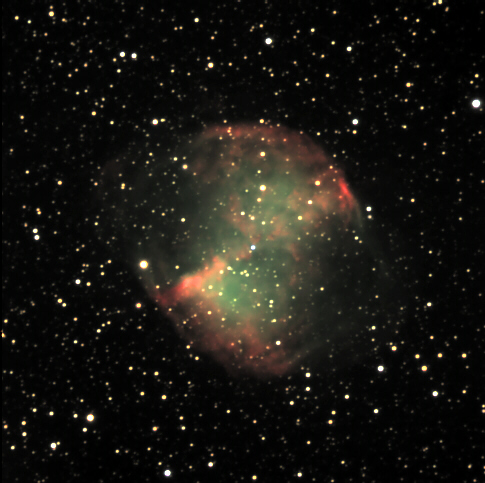
This image is a 10:8:8:8 minute LRGB exposure taken with
an SBIG ST-9E camera thru Kopernik's 20-inch F/8.1 telescope with the the
scope focal reduced to F/5.7. The field of view is about 12 x 12 arc minutes.

This image is a 10:8:8:8 minute LRGB exposure taken with
an SBIG ST-9E camera thru Kopernik's 20-inch F/8.1 telescope with the the
scope focal reduced to F/5.7. The field of view is about 12 x 12 arc minutes.
While M-27 is neither the largest nor the brightest planetary nebula in the sky, it may well be the easiest to view in a small telescope. It certainly offers the most detail. In small telescopes up to about 6 inch aperture the waisted ‘dumb-bell’ shape is quite obvious. However, in a larger scope, such as Kopernik’s 20 inch, an observer sees the brighter 'dumb-bell' shape surrounded by a continuous soft glow.
Discovered by Charles Messier on July 12th 1764, the Dumb-bell became an object of endless wonder to early observers. Until the late 19th century no one really understood what M-27 was. A randum sample of early observer’s impressions shows their confusion and wonder:
Messier: (July 12th, 1764) 'Nebula without star. Seen well in 3-foot telescope. Appears oval and contains no star.
W. Herschel: (Phil. Trans. 1785) Though its appearance is not large, it is probably a double stratum of stars of a very great extent, one end of which is turned towards us.......
Smyth: .....M 27 is truly one of those splendid enigmas which, according to Ricciolus, are proposed by God, but never to be subject to human solution......
Herschel named this type of object a ‘Planetary Nebula’ because the faint green tint and round shape reminded him of his recent discovery, the planet Uranus. He guessed (good guess, but wrong) that they were newly forming solar systems. We now know that they result when moderate to small stars reach old age. When stars begin to run short of their hydrogen nuclear fuel, their cores shrink, heat up, and start ‘burning’ helium. The outer parts of the star greatly expand, forming a red giant star. When even the helium is gone, the core collapses into a white dwarf star, and the outer parts escape into space, forming an expanding shell.
In M-27’s case, the central white dwarf star (old stellar core) has a surface temperature of about 85,000K. Ultra-violet light from this star causes oxygen in the nebula to glow a ghostly green, and hydrogen to glow red. Also, where the expanding shell runs into the interstellar gas (hydrogen) shock causes it to glow red also.
Distances to Planetary Nebulae are difficult to determine. A very rough estimate for M-27’s distance is 975 light years. If this is so, the predecessor red giant star died about 3,000 years ago. Note that the formation of a Planetary Nebula is a rather gentle event, nothing like the titanic explosions (supernovae) that mark the passing of heavy stars.